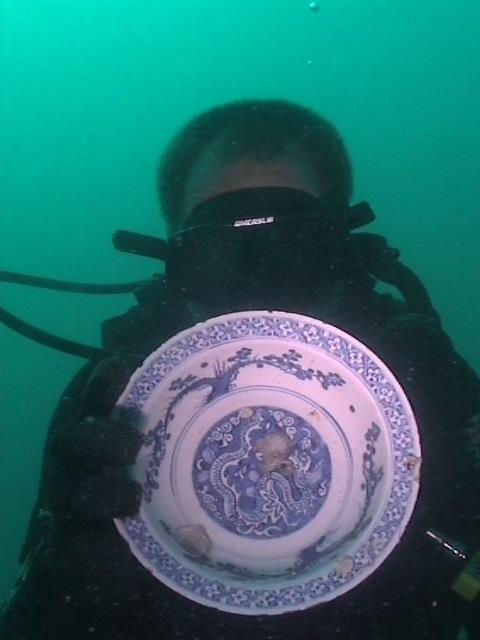Ming Porcelain in Enlightenment Portugal
- andrewsingerchina
- Dec 27, 2023
- 4 min read
Updated: Sep 8
Andrew Singer Talks About China and America, Vol. 2, Issue 38

Chapel Vestibule, Fronteira Palace
The Portuguese fell in love with Chinese porcelain during the sixteenth century. These translucent, blue-and-white export pieces were crisp, vibrant, and exotic. They were delicate yet durable.
Chinese porcelain spelled luxury. Royalty and the elite of Portuguese society desired it, sought it, and obtained it. These extravagant porcelain wares were shipped on European ships from Ming Dynasty China to Lisbon, the first capital of Europe’s maritime connection to Asia.

Chapel Vestibule, Fronteira Palace
Porcelain early on became part of unique Portuguese art. Embrechados were developed in the 17th and 18th centuries in Portugal. This style of garden art consisted of grotto inlays combining shells, stones, glass, and porcelain in ferrous slag. The porcelain bowls and plates used in embrechados were sometimes intact, but more often in shards.

Chapel Vestibule, Fronteira Palace
The best, preserved examples of this art form in Lisbon itself are located at the Palace of the Marquesses of Fronteira. The Palacio was originally a suburban hunting lodge founded several hundred years ago and still lived in by members of the noble Mascarenhas Family.

Fronteira Palace
The family moved full time to this, their summer escape, after the great 1755 earthquake destroyed their city home (and also much of Lisbon).

Formal Garden and King’s Gallery, Fronteira Palace
Though the city has since grown up around the property previously set amongst forested hills, the Fronteira Palace remains a time capsule of Portuguese Enlightenment elegance inside and out. It is also open to the public. Surviving embrechados at the Palace include installations in a Casa de Fresco grotto, a chapel vestibule, and on a fountain.

Casa de Fresco and Double S Basin
The estate originally boasted two Casas de Fresco (“Houses of Freshness”). The remaining grotto, first constructed in 1669, is located at the south side of the Venus Garden. A Double S-shaped receiving basin sits out front surrounded by outer benches. Arced fountains above the benches sent refreshing water into the receiving basin over the heads of those sitting below.

Case de Fresco grotto interior
There are a total of 192 pieces of porcelain bowls and plates, from intact wells to shards, at the Palace today. Most of these date to the Jiajing and Wanli periods of the Ming Dynasty. Their use as decoration and as art were part of the owner’s grand public statement that added allure, glamour, meaning, and prestige to his family.

Chapel Vestibule, Fronteira Palace
The chapel is located at the end of the grand Arts’ Terrace. Access down to the Casa de Fresco is from a set of stairs set in the vestibule to the left of the chapel entrance.

Chapel Vestibule at end of Arts’ Terrace, Fronteira Palace
One of three altars inside the chapel is dedicated to St. Francis Xavier (1506-1552). St. Francis was one of the co-founders of the Jesuit Order. Legend has it that before he departed Lisbon for India and China in 1541, St. Francis celebrated his last Mass here in the Fronteira Palace chapel.

View of Venus Garden from Chapel Vestibule, Fronteira Palace
The outdoor areas at the Palace were designed as summertime retreats. Shady trees, cool enclosures lined with Portugal’s renowned azulejo tiles and decorated with the embrechados, and several fountains with running water offered respite from the high heat of summer.

Venus Garden and Chapel Vestibule plus embrechados fountain lower right, Fronteira Palace
How do we know that the porcelain pieces used in Portuguese embrechados were from the Ming Dynasty?
We know thanks to the salvage of a 450-year-old shipwreck in 2001-2002. The ship sank in front of Fort San Sebastian in Mozambique off the southeast African coast. Although the site had been previously plundered during the 1990’s, the formal salvage yielded almost 1,000 intact or semi-intact porcelain objects as well as shards galore. Most of the porcelain pieces were blue and white’s decorated with qilin and other mythological animals, tigers, elephants, birds, flowers, and other designs.

Diver with bowl, Espadarte Salvage
One recovered piece in particular was the key to dating the porcelain. Based on the inscription on an underglaze cobalt-blue saucer, scientists and historians were subsequently able to conclusively date the piece as being fired in 1553. This was during the Jiajing reign (1522-1566) of the Ming Dynasty (1368-1644).
The ship from which these treasures come has been identified as the Espadarte, a Portuguese carrack (also called a nau). The Espadarte was returning from China by way of India in 1558, one year after the Portuguese obtained Chinese permission for an official settlement on Macau. She was laden with gold, spices, other rare merchandise, and lots of porcelain. Dishes, saucers, plates, bowls, and cups made up her fabulous blue-and-white cargo.

Espadarte Porcelain
Shippers enjoyed porcelain as a cargo. “Impermeable, easy to pack and store, and heavy in weight, [porcelain] was a perfect ballast for placing in the hold of ships to stabilize them for the long, dangerous sea voyages” (Orientations, March/April 2023). The Espadarte porcelains did not make it to Portugal; however, many thousands of other Chinese blue and white porcelains were successfully sailed into Lisbon for centuries to come.
Thank you for joining me on this journey to Fronteira Palace. I am glad that I had the opportunity to visit this gem in October. I wish everyone a Happy and Healthy New Year.





Comments